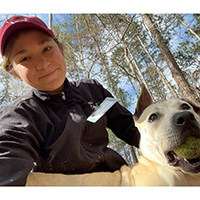 Jill Hancock with one of the dogs at the GBHSGiving back to the community is one of our core shared values at the Heersink School of Medicine. Be it a simple act of kindness or a year-long commitment, our faculty, staff, trainees, and students are determined to serve.
Jill Hancock with one of the dogs at the GBHSGiving back to the community is one of our core shared values at the Heersink School of Medicine. Be it a simple act of kindness or a year-long commitment, our faculty, staff, trainees, and students are determined to serve.
Community service is not limited to our fellow human beings; it transcends to all living creatures including animals. This staff member from our school lives by this idea by volunteering at the Greater Birmingham Humane Society.
Jill Hancock, clinical research coordinator in the Lifespan Comprehensive Sickle Cell Center, loves animals and at GBHS, she has a chance to spend time with them and care for them. She has a passion for animal adoption and rescue which she discovered when she adopted her first dog. It was a stray dog that was hit by a car outside Jill’s apartment in New Orleans.
“If the New Orleans shelter hadn’t come out to pick him up and treat him who knows what would have happened to him,” she recalls.
At GBHS, Hancock does not just care for these dogs, but also shares special moments with them. According to her, one of her most cherished memories with the dogs is organizing Easter photo shoots with them and taking Easter themed pictures for social media. “Trying to get dogs to wear bunny ears and pose by Easter baskets was beautifully chaotic and fun,” Hancock said.
The most rewarding feeling she experiences at the shelter is finding out that dogs that have been at the shelter for a while have been adopted.
“Everyone who loves animals and has a pet that’s close to their heart knows how important it is to get animals into loving, safe homes,” she said. “It’s good for the animals’ well-being and it’s good for the community to reduce the nu mber of strays.”
Hancock says that it is very easy to become a volunteer at GBHS. All it takes is going to the website, signing up for canine and feline care training classes, and committing a few hours each month to service.
Hancock’s volunteer journey with GBHS is filled with creating new bonds and friendships with the dogs and people at the shelter.
“Volunteering has given me a meaningful routine for the weekends. Also, the volunteer community at the shelter is full of great people and I’ve made several friends there since I started volunteering which is definitely fun after moving to a new place,” Hancock said.
Why volunteer?
Hancock encourages everyone to consider volunteering at the GBHS because “there are so many animals that need homes and adopting and fostering makes such a huge difference in the lives of animals who might otherwise live and die as strays or from neglect and abuse situations,” she says.
Volunteers make a huge difference for non-profit organizations like GBHS whose funding comes primarily from donations and grants. Animal shelters require housing, feeding, and providing medical care for thousands of animals each year. Volunteers can help fulfill many of these needs and even help driving transport vans of animals to partner shelters, which is scarce these days.
To share your volunteer story and encourage others, please contact